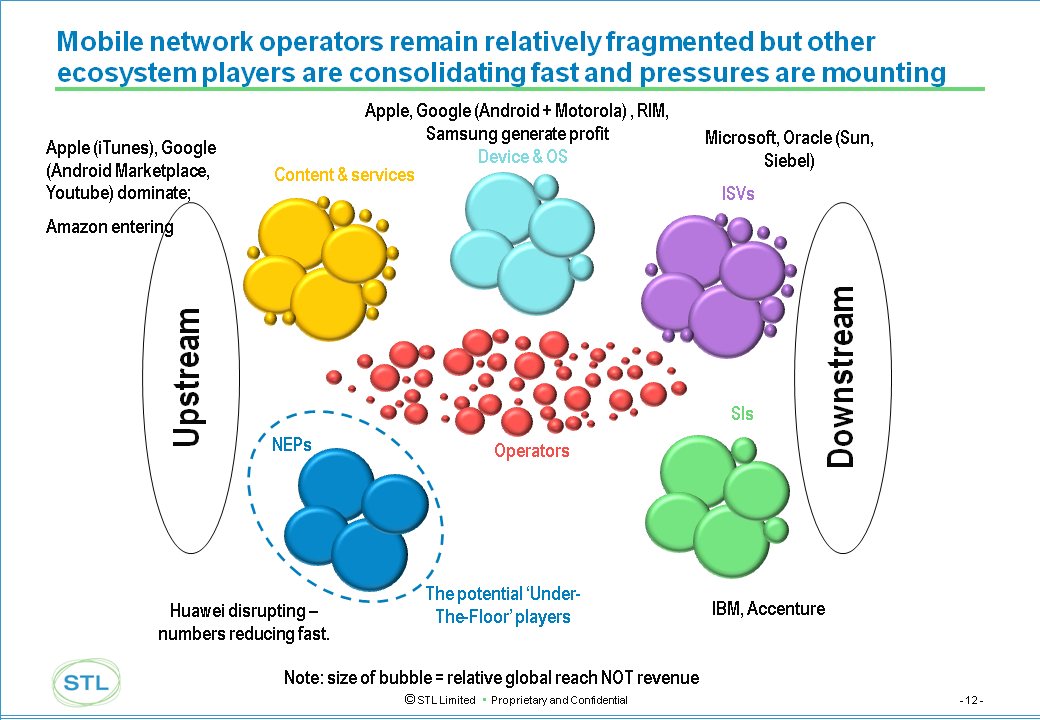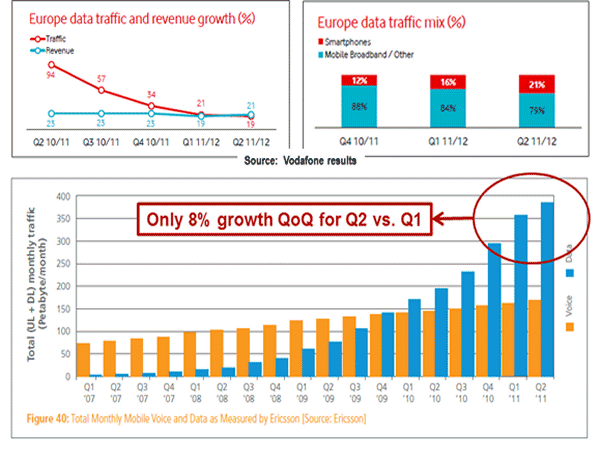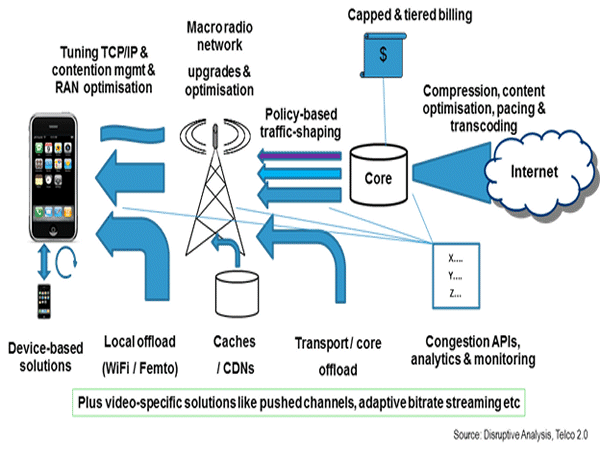Telco 2.0™ Research
The Future Of Telecoms And How To Get There
The Future Of Telecoms And How To Get There
| Summary: Key trends, tactics, and technologies for mobile broadband networks and services that will influence mid-term revenue opportunities, cost structures and competitive threats. Includes consideration of LTE, network sharing, WiFi, next-gen IP (EPC), small cells, CDNs, policy control, business model enablers and more.(March 2012, Executive Briefing Service, Future of the Networks Stream). |
|
Below is an extract from this 44 page Telco 2.0 Report that can be downloaded in full in PDF format by members of the Telco 2.0 Executive Briefing service and Future Networks Stream here. Non-members can subscribe here, buy a Single User license for this report online here for £795 (+VAT for UK buyers), or for multi-user licenses or other enquiries, please email / call +44 (0) 207 247 5003. We'll also be discussing our findings and more on Facebook at the Silicon Valley (27-28 March) and London (12-13 June) New Digital Economics Brainstorms.
To share this article easily, please click:Telco 2.0 has previously published a wide variety of documents and blog posts on mobile broadband topics – content delivery networks (CDNs), mobile CDNs, WiFi offloading, Public WiFi, network outsourcing (“'Under-The-Floor' (UTF) Players: threat or opportunity? ”) and so forth. Our conferences have featured speakers and panellists discussing operator data-plan pricing strategies, tablets, network policy and numerous other angles. We’ve also featured guest material such as Arete Research’s report LTE: Late, Tempting, and Elusive.
In our recent 'Under the Floor (UTF) Players' Briefing we looked at strategies to deal with some of of the challenges facing operators' resulting from market structure and outsourcing

This Executive Briefing is intended to complement and extend those efforts, looking specifically at those technical and business trends which are truly “disruptive”, either immediately or in the medium-term future. In essence, the document can be thought of as a checklist for strategists – pointing out key technologies or trends around mobile broadband networks and services that will influence mid-term revenue opportunities and threats. Some of those checklist items are relatively well-known, others more obscure but nonetheless important. What this document doesn’t cover is more straightforward concepts around pricing, customer service, segmentation and so forth – all important to get right, but rarely disruptive in nature.
During 2012, Telco 2.0 will be rolling out a new MBB workshop concept, which will audit operators’ existing technology strategy and planning around mobile data services and infrastructure. This briefing document is a roundup of some of the critical issues we will be advising on, as well as our top-level thinking on the importance of each trend.
It starts by discussing some of the issues which determine the extent of any disruption:
The report then drills into a few particular domains where technology is evolving, looking at some of the most interesting and far-reaching trends and innovations. These are split broadly between:
It is not feasible for us to cover all these areas in huge depth in a briefing paper such as this. Some areas such as CDNs and LTE have already been subject to other Telco 2.0 analysis, and this will be linked to where appropriate. Instead, we have drilled down into certain aspects we feel are especially interesting, particularly where these are outside the mainstream of industry awareness and thinking – and tried to map technical evolution paths onto potential business model opportunities and threats.
This report cannot be truly exhaustive – it doesn’t look at the nitty-gritty of silicon components, or antenna design, for example. It also treads a fine line between technological accuracy and ease-of-understanding for the knowledgeable but business-focused reader. For more detail or clarification on any area, please get in touch with us – email or call +44 (0) 207 247 5003.
There are various potential sources of disruption for the mobile broadband marketplace:
The majority of this report covers “official” telco-centric innovations – LTE networks, new forms of policy control and so on,
But the most dangerous form of innovation is that from third parties, which can undermine assumptions about the ways mobile broadband can be used, introducing new mechanisms for arbitrage, or somehow subvert operators’ pricing plans or network controls.
In the voice communications world, there are often regulations in place to protect service providers – such as banning the use of “SIM boxes” to terminate calls and reduce interconnection payments. But in the data environment, it is far less obvious that many work-arounds can either be seen as illegal, or even outside the scope of fair-usage conditions. That said, we have already seen some attempts by telcos to manage these effects – such as charging extra for “tethering” on smartphones.
It is not really possible to predict all possible disruptions of this type – such is the nature of innovation. But by describing a few examples, market participants can gauge their level of awareness, as well as gain motivation for ongoing “scanning” of new developments.
Some of the areas being followed by Telco 2.0 include:
It is also really important to recognise that certain procedures and technologies used in policy and traffic management will likely have some unanticipated side-effects. Users, devices and applications are likely to respond to controls that limit their actions, while other developments may result in “emergent behaviours” spontaneously. For instance, there is a risk that too-strict data caps might change usage models for smartphones and make users just connect to the network when absolutely necessary. This is likely to be at the same times and places when other users also feel it necessary, with the unfortunate implication that peaks of usage get “spikier” rather than being ironed-out.
There is no easy answer to addressing these type of external threats. Operator strategists and planners simply need to keep watch on emerging trends, and perhaps stress-test their assumptions and forecasts with market observers who keep tabs on such developments.
It is an undisputed fact that mobile data is growing exponentially around the world. Or is it?
Telco 2.0 certainly thinks that growth in data usage is occurring, but is starting to see signs that the smooth curves that drive so many other decisions might not be so smooth – or so steep – after all. If this proves to be the case, it could be far more disruptive to operators and vendors than any of the individual technologies discussed later in the report. If operator strategists are not at least scenario-planning for lower data growth rates, they may find themselves in a very uncomfortable position in a year’s time.
In its most recent study of mobile operators’ traffic patterns, Ericsson concluded that Q2 2011 data growth was just 8% globally, quarter-on-quarter, a far cry from the 20%+ growths seen previously, and leaving a chart that looks distinctly like the beginning of an S-curve rather than a continued “hockey stick”. Given that the 8% includes a sizeable contribution from undoubted high-growth developing markets like China, it suggests that other markets are maturing quickly. (We are rather sceptical of Ericsson’s suggestion of seasonality in the data). Other data points come from O2 in the UK , which appears to have had essentially zero traffic growth for the past few quarters, or Vodafone which now cites European data traffic to be growing more slowly (19% year-on-year) than its data revenues (21%). Our view is that current global growth is c.60-70%, c.40% in mature markets and 100%+ in developing markets.

Now it is possible that various one-off factors are at play here – the shift from unlimited to tiered pricing plans, the stronger enforcement of “fair-use” plans and the removal of particularly egregious heavy users. Certainly, other operators are still reporting strong growth in traffic levels. We may see resumption in growth, for example if cellular-connected tablets start to be used widely for streaming video.
But we should also consider the potential market disruption, if the picture is less straightforward than the famous exponential charts. Even if the chart looks like a 2-stage S, or a “kinked” exponential, the gap may have implications, like a short recession in the economy. Many of the technical and business model innovations in recent years have been responses to the expected continual upward spiral of demand – either controlling users’ access to network resources, pricing it more highly and with greater granularity, or building out extra capacity at a lower price. Even leaving aside the fact that raw, aggregated “traffic” levels are a poor indicator of cost or congestion, any interruption or slow-down of the growth will invalidate a lot of assumptions and plans.
Our view is that the scary forecasts of “explosions” and “tsunamis” have led virtually all parts of the industry to create solutions to the problem. We can probably list more than 20 approaches, most of them standalone “silos”.

What seems to have happened is that at least 10 of those approaches have worked – caps/tiers, video optimisation, WiFi offload, network densification and optimisation, collaboration with application firms to create “network-friendly” software and so forth. Taken collectively, there is actually a risk that they have worked “too well”, to the extent that some previous forecasts have turned into “self-denying prophesies”.
There is also another common forecasting problem occurring – the assumption that later adopters of a technology will have similar behaviour to earlier users. In many markets we are now reaching 30-50% smartphone penetration. That means that all the most enthusiastic users are already connected, and we’re left with those that are (largely) ambivalent and probably quite light users of data. That will bring the averages down, even if each individual user is still increasing their consumption over time. But even that assumption may be flawed, as caps have made people concentrate much more on their usage, offloading to WiFi and restricting their data flows. There is also some evidence that the growing numbers of free WiFi points is also reducing laptop use of mobile data, which accounts for 70-80% of the total in some markets, while the much-hyped shift to tablets isn’t driving much extra mobile data as most are WiFi-only.
So has the industry over-reacted to the threat of a “capacity crunch”? What might be the implications?
The problem is that focusing on a single, narrow metric “GB of data across the network” ignores some important nuances and finer detail. From an economics standpoint, network costs tend to be driven by two main criteria:
Coverage is (generally) therefore driven by factors other than data traffic volumes. Many cells have to be built and run anyway, irrespective of whether there’s actually much load – the operators all want to claim good footprints and may be subject to regulatory rollout requirements. Peak capacity in the most popular locations, however, is a different matter. That is where issues such as spectrum availability, cell site locations and the latest high-speed networks become much more important – and hence costs do indeed rise. However, it is far from obvious that the problems at those “busy hours” are always caused by “data hogs” rather than sheer numbers of people each using a small amount of data. (There is also another issue around signalling traffic, discussed later).
Yes, there is a generally positive correlation between network-wide volume growth and costs, but it is far from perfect, and certainly not a direct causal relationship.
So let’s hypothesise briefly about what might occur if data traffic growth does tail off, at least in mature markets.
Overall, it is still a little too early to declare shifting growth patterns for mobile data as a “disruption”. There is a lack of clarity on what is happening, especially in terms of responses to the new controls, pricing and management technologies put recently in place. But operators need to watch extremely closely what is going on – and plan for multiple scenarios.
Specific recommendations will depend on an individual operator’s circumstances – user base, market maturity, spectrum assets, competition and so on. But broadly, we see three scenarios and implications for operators:
To read the note in full, including the following analysis...
...and the following figures...
...Members of the Telco 2.0 Executive Briefing Subscription Service and Future Networks Stream can download the full 44 page report in PDF format here. Non-Members, please subscribe here, buy a Single User license for this report online here for £795 (+VAT for UK buyers), or for multi-user licenses or other enquiries, please email / call +44 (0) 207 247 5003.
Organisations, geographies, people and products referenced: 3GPP, Aero2, Alcatel Lucent, AllJoyn, ALU, Amazon, Amdocs, Android, Apple, AT&T, ATIS, BBC, BlackBerry, Bridgewater, CarrierIQ, China, China Mobile, China Unicom, Clearwire, Conex, DoCoMo, Ericsson, Europe, EverythingEverywhere, Facebook, Femto Forum, FlashLinq, Free, Germany, Google, GSMA, H3G, Huawei, IETF, IMEI, IMSI, InterDigital, iPhones,Kenya, Kindle, Light Radio, LightSquared, Los Angeles, MBNL, Microsoft, Mobily, Netflix, NGMN, Norway, NSN, O2, WiFi, Openet, Qualcomm, Radisys, Russia, Saudi Arabia, SoftBank, Sony, Stoke, Telefonica, Telenor, Time Warner Cable, T-Mobile, UK, US, Verizon, Vita, Vodafone, WhatsApp, Yota, YouTube, ZTE.
Technologies and industry terms referenced: 2G, 3G, 4.5G, 4G, Adaptive bitrate streaming, ANDSF (Access Network Discovery and Selection Function), API, backhaul, Bluetooth, BSS, capacity crunch, capex, caps/tiers, CDMA, CDN, CDNs, Cloud RAN, content delivery networks (CDNs), Continuous Computing, Deep packet inspection (DPI), DPI, DRM, Encryption, Enhanced video, EPC, ePDG (Evolved Packet Data Gateway), Evolved Packet System, Femtocells, GGSN, GPS, GSM, Heterogeneous Network (HetNet), Heterogeneous Networks (HetNets), HLRs, hotspots, HSPA, HSS (Home Subscriber Server), HTML5, HTTP Live Streaming, IFOM (IP Flow Mobility and Seamless Offload), IMS, IPR, IPv4, IPv6, LIPA (Local IP Access), LTE, M2M, M2M network enhancements, metro-cells, MiFi, MIMO (multiple in, MME (Mobility Management Entity), mobile CDNs, mobile data, MOSAP, MSISDN, MVNAs (mobile virtual network aggregators)., MVNO, Net Neutrality, network outsourcing, Network sharing, Next-generation core networks, NFC, NodeBs, offload, OSS, outsourcing, P2P, Peer-to-peer connectivity, PGW (PDN Gateway), picocells, policy, Policy and Charging Rules Function (PCRF), Pre-cached video, pricing, Proximity networks, Public WiFi, QoE, QoS, RAN optimisation, RCS, remote radio heads, RFID, self-optimising network technology (SON), Self-optimising networks (SON), SGW (Serving Gateway), SIM-free wireless, single RANs, SIPTO (Selective IP Traffic Offload), SMS, SoftSIM, spectrum, super-femtos, Telco 2.0 Happy Pipe, Transparent optimisation, UMTS, 'Under-The-Floor' (UTF) Players, video optimisation, VoIP, VoLTE, VPN, White space, WiFi, WiFi Direct, WiFi offloading, WiMAX, WLAN.